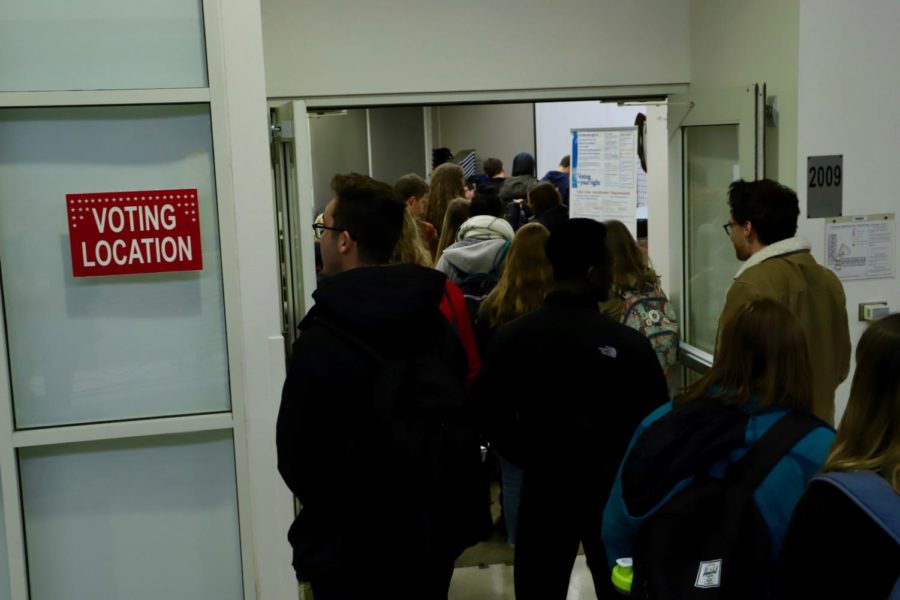Iowa State student voting rate jumped in 2018 midterm election
Patrick Schmidt/ Iowa State Daily
Students wait in line to vote for the 2018 midterm election Nov. 6, 2018, inside Buchanan Hall.
September 24, 2019
Iowa State students voted in the 2018 midterm elections at a rate nearly double their 2014 midterm turnout rate.
The student voter turnout rate at Iowa State in 2018 was 40.6 percent, compared to 22.6 percent in 2014, per the National Study of Learning, Voting, and Engagement. This spike in turnout coincided with a national voter turnout spike from 36.4 percent in 2014 to 50.3 percent in 2018, meaning Iowa State students had a greater spike in voter turnout than the country as a whole.
Furthermore, the turnout rate at Iowa State was 1.5 percent higher than all higher education institutions across the country, according to the study. Among voters aged 18-21 at Iowa State, turnout jumped from 18 percent to 34.9 percent. Undergraduate student voter turnout jumped by a greater percentage than graduate students, but graduate students still had a 4.5 percent higher voter turnout rate at 40.1 percent, according to the study.
Students in “public administration and social service professions” fields of study had the highest voter turnout rate, at 63.6 percent, while those in “computer and information sciences” had the lowest voter turnout rate, at 28.9 percent.
Turnout among eligible “upper-level” students in 2018 was highest — with 38.2 percent voting, 33.2 percent of sophomores voted and 30.4 percent of first year students going to the polls — turnout increases of 17 percent, 16 percent and 15.5 percent from 2014 respectively.
In line with national trends — women students at Iowa State turnout out to vote in 2018 at a higher rate than men. 39.6 percent of eligible women turned out to vote at Iowa State, compared to 33.2 percent of men.
Part-time students at Iowa State voted at a rate near the national level, with 50.8 percent voting in 2018, an increase of 13.1 percent from 2014. 35 percent of full-time students voted in 2018, an increase of 16.4 percent from 2014.
Vote Everywhere is a student organization at Iowa State with goals including increasing voter turnout and ensuring students are registered to vote.
Hayat Sumael, the president of the organization and a sophomore in criminal justice studies, said she thinks the voter turnout increase at Iowa State is “amazing.”
“[O]ur voting rate is a little above the national average,” Sumael said. “We still have a little work to do because we are still under 50 percent, but I’m hoping our civic engagement efforts on campus will make Iowa State’s voting rate even higher especially with the 2020 elections coming. I definitely see it going up from here!”
Karen Kedrowski, director of the Carrie Chapman Catt Center for Women and Politics and the club’s adviser, said the 2018 election saw a record voter turnout increase — climbing to a rate near that of presidential elections.
“The turnout rate for college students is slightly higher than for all young voters (39% nationally), which I don’t find surprising,” Kedrowski said in an email. “Voter turnout is highly correlated with education. ISU’s voter turnout rate (40.6%) is slightly higher than for all colleges, which I find gratifying.”
Mack Shelley, Iowa State professor and chair of the political science department, said President Donald Trump has activated support among voters on both sides of the partisan divides, generating higher turnout among those who support him and those who do not.
Shelley said those who do not support Trump could be voting, for example, based on the fear of another four years of him as president, and he spoke of push and pull factors. Those who are inclined to support Democrats are pulled to support those candidates by their shared values and ideology, Shelley said.
“The doubling of voter turnout by younger voters — you could argue that had a lot to do with the fact that there was a perception that Trump was a threat to a mindset or way of life, or the general approach to […] everything.” Shelley said. “That’s kind of the push factor [to turning out to vote].”
Many voters are “unhappy” with the current administration and voted for Democrats either in protest or to block policies, Kedrowski said.
“There is quite a lot of evidence that this contributed to increased voter turnout in 2018,” Kedrowski said. I also think that young people are especially motivated by particular issues that were salient in the last election: the environment, education, and gun violence in particular, and in some regions, immigration. In addition, many college campuses are […] becoming intentional about encouraging students to vote and to educate them on candidates and elections. Iowa State is among them, and I applaud the work of Kelly Winfrey and the students she worked with to increase voter turnout at ISU.”







